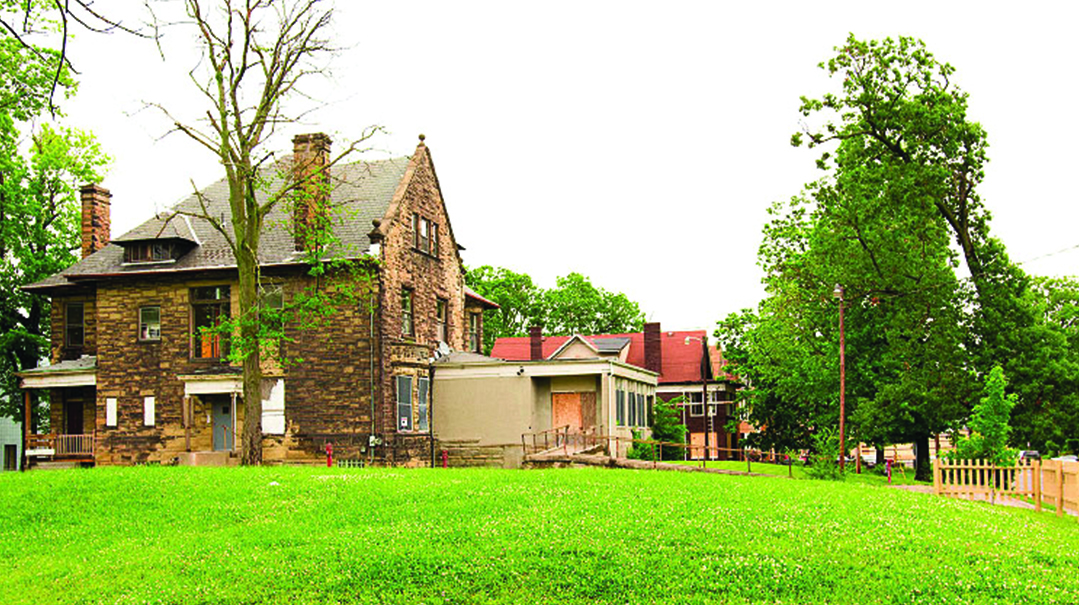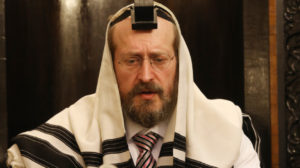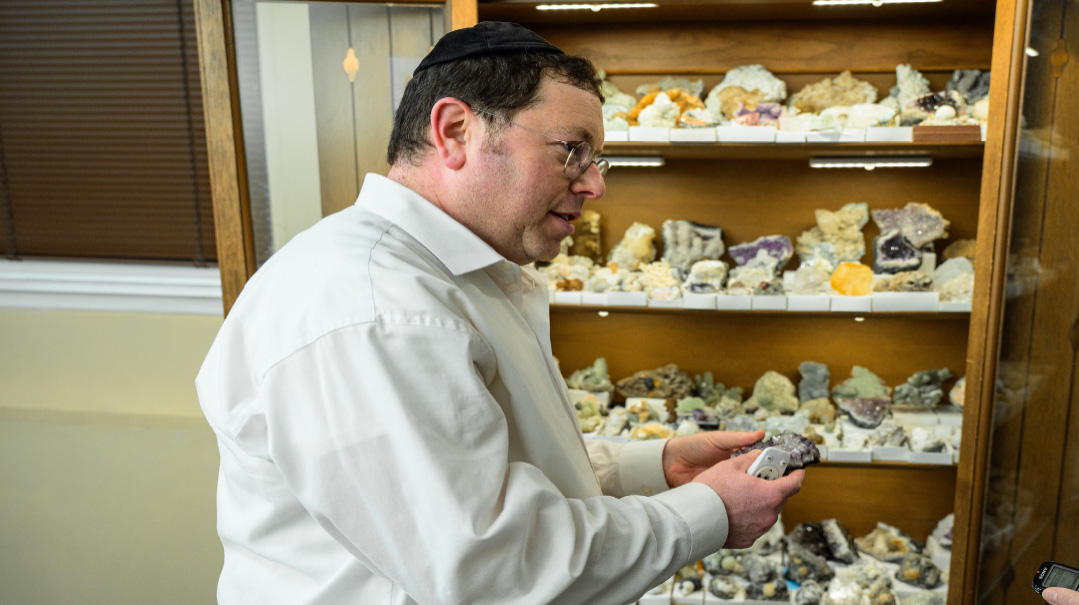Noble Footsteps in the Queen City

Old Cincinnati, as seen through the eyes of a talmid of Rav Eliezer Silver

The spot where Rav Silver’s shul once stood at the corner of Washington and Rockdale Avenues is now the home of the Boys & Girls Clubs of Greater Cincinnati. There is no sign that a majestic synagogue once stood on that spot but for Mr. Eichelberg a local community askan who helped build many of Cincinnati’s shuls over the years the memories are fresh. “A rebbi is forever ” Mr. Eichelberg declares (Photos: Laky Majeski Marc Randolph & The Cincinnati Judaica Fund)
R av Eliezer Silver is best known for leading the Vaad Hatzalah during World War II but fewer remember him as a community rav.
Mr. Hugo Eichelberg now 87 was one of those who could call Rav Silver his rebbi. As a young man Mr. Eichelberg attended Knesseth Israel where Rav Silver led the congregation for 37 years.
Those long-ago days were the subject of a recent tour in Cincinnati conducted by the Cincinnati Judaica Fund and Congregation Zichron Eliezer the successor congregation to Knesseth Israel (or KI as the old-timers still call it) and the biggest shul in Cincinnati. Rabbi Silver’s shul was rededicated in his name when it moved to its current home in 2009.
Of course the frum community in Cincinnati today is also notable and growing with multiple synagogues and schools a state-of-the-art mikveh an exciting day camp and a strong and active kollel. The town known for its impressive old homes and friendly atmosphere has become a choice for many young families who want to live the “out of town” life.
A Rebbi is Forever
In the early part of the 20th century Cincinnati was a destination on the Jewish map in part because of Rav Silver’s outsized contribution to the Jewish people. The founder of Agudath Israel of America first came to Cincinnati in 1931 after serving as the community rabbi in Harrisburg Pennsylvania and Springfield Massachusetts starting in 1907.
Today Mr. Eichelberg leads us to the spot where Rav Silver’s shul Knesseth Israel once stood. It’s in the North Avondale neighborhood of Cincinnati a formerly frum part of town that the community left behind in the 1960s. North Avondale is no longer recognizable as formerly Jewish — with shuls turned into churches and kosher butcher shops now family dollar stores — but the memories remain.
The spot where Rav Silver’s shul once stood at the corner of Washington and Rockdale Avenues is now the home of the Boys & Girls Clubs of Greater Cincinnati. There is no sign that a majestic synagogue once stood on that spot but for Mr. Eichelberg a local community askan who helped build many of Cincinnati’s shuls over the years the memories are fresh. “A rebbi is forever ” Mr. Eichelberg declares as he begins to quote Rav Silver’s psakim (halachic decisions) as if hearing them for the first time: the best time to daven Shacharis while traveling the order of Erev Pesach when it falls on a Friday hilchos Chanukah.
Payback Time
Before Rav Silver and a group of balabatim (including Ben Berkowitz son-in-law of Rav Yisroel Belsky ztz”l) opened the Cincinnati Hebrew Day School in 1947 there was an after-school yeshivah called Yeshivas Etz Chaim that taught the boys after public school.
The school founded in 1915 was led by rosh yeshivah Rav B.Z. Parchesky. When the Ponevezher Rav came to Cincinnati to collect from the Jaffee family in Dayton — well-known philanthropists of the time who made their money in the scrap-metal business and who were staunch supporters of Ponevezh — the Rav would stay with Rav Parchesky or Rav Silver for Shabbos and go to Dayton on Sunday.
Mr. Eichelberg recalled that on one of these trips the Ponevezher Rav asked Rav Parchesky who was recognized as an illui what he was doing in a small town like Cincinnati. “You belong in New York or Chicago ” the Ponevezher Rav said. Rav Parchesky replied that the Ponevezher Rav was right. He could’ve gone to Chicago or New York to lead a congregation but he chose to dedicate himself to chinuch to honor his parents.
“When I grew up in Poland ” Rav Parchesky said “my parents were very poor. They had nothing but one cow that gave them milk to support our family. They took that cow and sold it so they had enough money to send me to yeshivah so that I could become a talmid chacham. That’s why I’m here in Cincinnati. I’m merely paying back what my parents gave to me.”
Manischewitz’s Mitzvah Mansion
Continuing on our tour, we reach Forest Avenue, a block many have passed without realizing its signifance to the history of Jews in Cincinnati.
Three shuls formerly stood on the block, along with the mansion of one of the most famous names in modern Jewish life: Manischewitz. Mr. Eichelberg brings us back 60 years, vividly describing how the KI congregants would come together on Shemini Atzeres for a big party at Rav Silver’s house on Hickory Street and then walk back to Forest Avenue, where men and boys would parade up and down the street, waving Simchas Torah flags.
The Manischewitz family opened their small matzah bakery in Cincinnati in 1888. The family brought in mashgichim who certified the matzah under the watchful eyes of Rav Silver and were the first company in the world to make square matzos.
The founder, Rabbi Hirsch Behr was extremely close to Rav Silver and hosted him when the Rav came to Cincinnati in the 1920s while he was still a rabbi in Springfield, Massachusetts. At the time, Rav Silver travelled to Cincinnati to attend the Central Conference of American Rabbis convention and hold meetings on the pogroms in Russia. Why did Rav Silver attend this convention of a Reform organization and meet with its leaders? Very simple, says Mr. Eichelberg, the Rav needed the help of the Reform movement.
As Mr. Yaacov Rabenstein, a noted askan who also grew up in Cincinnati, said, “Rabbi Silver didn’t care where he needed to go if it meant helping another Yid.”
The Manischewitz mansion had its own mikveh, unheard of in those days. Later, the home would serve as the first location for the Cincinnati Hebrew Day School and would be used by the Young Israel of Cincinnati. It was also the nerve center for the yeshivah that Hirsch Behr opened in Palestine in 1914 (the Rabbi Behr Manischewitz Yeshivah), one that he fully funded and helped operate.
Those on the tour hoping to marvel at the sight of the impressive home were disappointed, however, to find that only a patch of grass remains.
Next to the house is Fleischmann Gardens, a quaint park where the day-school kids played during lunch hour and where Rav Silver would also say Tashlich every Rosh Hashanah.
Coverage for a Traveling Rav
Rav Silver frequently traveled to New York, Europe, Washington, and Eretz Yisrael to come to the aid of the Jewish people. Eventually, Rav Silver brought in Rabbi Leib Potashnik to ensure there was a rav in town available to answer sh’eilos when he was away. Rabbi Potashnik was the rabbi of Congregation Beth Hamedrash Hagodol. He was a great talmid chacham and his yiras Shamayim shone through in every psak.
Mr. Eichelberg tells us a story that stands out in his mind. When a housewife would bring Rabbi Potashnik a chicken with a sh’eilah, the rabbi would ask, “How much did the chicken cost you?” If the housewife would answer, “$5,” he would pull the money out of his pocket and give it to her, saying, “Take this $5 and let me keep the chicken.” Why? The rabbi preferred to buy the woman a new chicken rather than pasken on it and possibly call it treif.
The Mikveh Showdown of 1932
Rockdale Temple, one of the largest and first Reform temples in Cincinnati, started off as an Orthodox shul. The impressive congregation had its own mashgiach, matzah ovens, and mikveh. So how did it become Reform?
“We Yekkehs say yotzros often,” Mr. Eichelberg explained. “The people of Rockdale were tired of saying yotzros and wanted to stop. Someone suggested they send in a sh’eilah before making any decision to stop a long-standing minhag. They sent the sh’eilah to a posek in the New York/New Jersey area and were told that they couldn’t stop saying yotzros. “The moment you stop,” the posek warned, “you are one step closer to assimilation and you will ultimately assimilate completely if you do.”
Ultimately, the posek’s words proved true. By the time Rav Silver came to town in 1931, Rockdale Temple was an anti-Orthodox institution that would ultimately take Rav Silver and his kehillah to court.
An older woman who owned a house behind Rockdale donated the dwelling to Rav Silver so that Knesseth Israel could build a mikveh. Rockdale’s members didn’t want a mikveh anywhere near their building, however, so they complained to the city’s zoning board. The matter ended up in court where Rav Silver was represented by his dear friend Robert Taft, son of US President William Howard Taft, who would later serve as the United States Senator from Ohio from 1939–1953. Rav Silver described to Mr. Taft the vital role of a mikveh in the daily life of a Jew and he successfully convinced him to take the case.
The attorney for Rockdale decided to put Rav Silver on the stand — against the advice of his peers. He tried to make a fool of the Rav, pestering him with questions until finally asking him, in wonder, “And surely the good rabbi does not believe the story of the talking donkey,” referring to Bilaam’s animal. To which Rav Silver, known for his sharp wit, replied by lifting up his finger and pointing straight at the attorney. “Now I do,” he said, as the courtroom broke out in laughter.
The judge, a blind Roman Catholic, was very impressed with Rav Silver’s explanations for the religious needs of a mikveh and allowed its construction so long as it was used as a place of worship. From then on, once a year, a Minchah minyan was held at the mikveh to comply with the judge’s orders. The mikveh stood in that very location for the next 30 years.
Bar Mitzvah with Uninvited Guests
Cincinnati’s Jewish Community Center (JCC) today is a beautiful, sprawling multimillion-dollar campus with a kosher kitchen and cafe, workout facilities, and a swimming pool with separate weeknight hours for men and women.
But that’s a far cry from the previous JCC, a fact that Mr. Eichelberg knows all too well. In October of 1942, his bar mitzvah was set to take place there and his mother had prepared everything for the bar mitzvah prior to Shabbos, including the bar mitzvah cake. However, when they walked in the next morning, uninvited guests — namely, rats — had visited overnight and had a taste of the cake. The caretaker advised young Hugo’s mother to “take the cake home and put some new icing on it and no one will ever know the difference,” but Mr. Eichelberg’s mother refused and tossed it in the garbage. Said Mr. Eichelberg: “That is why I’m crazy as I am today. I never had my bar mitzvah cake!”
Reform Interactions
Cincinnati is well-known as the home of Reform Judaism in America and Hebrew Union College, the movement’s training institute. Wise Temple, a major Reform congregation, had moved from downtown Cincinnati to North Avondale in the 1920s.
Mr. Eichelberg tells a story about meeting that congregation’s spiritual leader, Samuel Wohl, one Shabbos morning. Young Hugo was walking with Rav Silver to shul when Wohl passed by. “Good Shabbos, Rabbi Silver,” Wohl said, but Rabbi Silver did not respond. In his innocence, young Hugo answered, “Good Shabbos, Rabbi Wohl” — and the Rav was not happy. “How dare you address him as a ‘rabbi’?” said Rav Silver. “Since when is he a rabbi? And since when do you say ‘good Shabbos’ to a chotei u’machatie (someone who convinces others to sin)? He is mechallel shabbos b’farhesya!”
Interestingly enough, the original Wise Temple housed Knesseth Israel in its basement when the Orthodox shul first opened in 1916. That arrangement lasted for a few years until Nelson Glueck (who was later the president of Hebrew Union College) became president of Wise Temple and ended the arrangement. While Glueck led Hebrew Union College, his close relation Rabbi Dr. Bernard Revel headed Rabbi Isaac Elchanan Theological Seminary (RIETS).
Everlasting Gifts
In the 1800s and early 1900s, American medical schools imposed a strict quota on the number of Jewish students they admitted, and Jewish physicians were denied privileges to practice in hospitals. In response, Jews opened hospitals of their own.
The Jewish Hospital of Cincinnati, the first Jewish hospital in the United States, was founded in 1854 by the Cincinnati Jewish community. Rabbi Louis Feinberg of Adath Israel (rabbi from 1918–1949) ensured that there was kosher food available every Pesach and eventually built a kosher kitchen in the hospital. The building also had its own bris milah room, a rarity for the 1930s.
In 2010, the hospital was sold for over $180 million. With the sale proceeds, the Jewish Foundation of Cincinnati invests over $15 million each year in Cincinnati’s Jewish community. The Jewish Foundation of Cincinnati provides over $1 million per year to the Cincinnati Hebrew Day School, along with annual grants to shuls, the kollel, and to help parents pay for Jewish summer camp and yeshivah and seminary in Israel after high school. All these years later, the Jews of Cincinnati are still being helped by the original group of askanim who founded the Jewish Hospital 165 years ago.
Lesson of the Century
We were left with one last story, a life lesson that was dear to the heart of Mr. Eichelberg. He told a story about the Suvalker Rav, Rav Dovid Lifshitz ztz”l, who was related to Mr. Eichelberg’s late wife Evelyn a”h and who was also the rebbi of the Eichelbergs’ son-in-law at RIETS.
A few days after the wedding of the Eichelbergs’ daughter in New York, Rav Dovid asked the Eichelbergs to come visit him at his home in Washington Heights at 2 p.m. The Eichelbergs left by subway from Boro Park at 11:45, but, being from Cincinnati, got lost and ended up in the Bronx. By the time they made it to Rav Dovid’s house, it was 4 p.m.
When they arrived, Rav Dovid informed them that on an ordinary winter day he would ask Mr. Eichelberg to accompany him to Minchah. But under the circumstances they couldn’t go. “Why not?” asked Mr. Eichelberg. “Your wife is here,” said Rav Dovid. “So what?” he replied. Rav Dovid said, “The mitzvah of hachnassas orchim is more important than tefillah b’tzibbur.”
Mr. Eichelberg was so impressed by Rav Dovid’s response that he has repeated this story to young and old alike for the past 35 years. In Mr. Eichelberg’s words, “Please remember that Rav Dovid and Rav Silver both held of the extreme importance of mitzvos bein adam l’chaveiro. [They both taught] that when you are doing a mitzvah with a fellow Yid, you are doing both bein adam l’chaveiro and bein adam l’Makom.”
The writer would like to thank Marc Randolph, Esq., and the Cincinnati Judaica Fund for providing much of the background, documents, and photographs for the history of the institutions mentioned.
(Originally featured in Mishpacha, Issue 672)
Oops! We could not locate your form.













